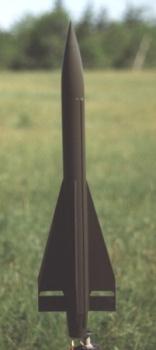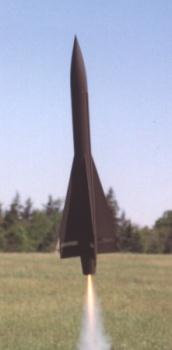The Launch Pad Improved Hawk MIM-23B
The Launch Pad - Improved Hawk MIM-23B {Kit}
Contributed by Kevin Drayson
| Construction Rating: | starstarstarstarstar_border |
| Flight Rating: | starstarstarstarstar |
| Overall Rating: | starstarstarstarstar_border |
| Manufacturer: | The Launch Pad  |
 Brief
Brief
This is a single-stage, mid-power scale model of a US Army surface to air missile.
Construction
Like all kits I've received from The Launch Pad, this one arrived in a plastic bag, like most of the Estes kits you see hanging in stores. All the needed parts were accounted for, and in good shape: a big mylar chute, centering rings, swivels, braided elastic shock cord, card-stock templates, Estes-style nose cone and tubes, and balsa sheets and strips.
The instructions were clear and concise. Templates were included for cutting out the balsa parts to make the fins (three parts to each!). Card templates are also included to make the boat tail and the "hat" for the nose cone, to give it a truer shape. As with all TLP kits, you are on your own for launch lug placement.
Building was straight-forward, with one exception- the boat tail assembly seems to be short a centering ring- there is only one that actually holds the part to the main tube. I think it's a bit flimsy, but time will tell. I would have liked a second one, but I discovered the problem too late. The nose cone "hat" was a bit tough to roll into shape without creasing, even using the recommended steaming procedure.
The rest of the kit went together without incident, and the final product looks pretty good!
Finishing
As with all Launch Pad kits, there are no decals included. The instructions recommend an overall olive drab scheme, and point out positions for black lettering. I finished mine in the recommended green, using Ultracote Olive Drab. This is the first TLP kit I've built that didn't mention using pinheads for rivets, a suggestion I don't miss.
Overall, the rocket looks pretty convincing, if not terribly colorful.
I rate it a 4 out of 5, losing points mainly for the nasty boat tail problem, and a bit for the nose hat and lack of decals.
Construction Rating: 4 out of 5
 Flight
Flight
The first flight recommended motor is a D12-3. I managed to trade for one at a recent launch, and got to fly my I-Hawk. Booster was quick and straight, although the missile seemed to lock onto a high-flying jet liner- bonus points for scale-like flight, I suppose. I used about 10 squares of wadding, wanting to make sure that nothing went wrong.
Recovery
The chute was deployed pretty close to apogee, and the big mylar chute brought the rocket down safely. No damage or wear was evident, but I intend to replace the thread that connects the nose to the shock cord- it snapped on my Harpoon later that day. A good first flight, with everything working as advertised.
Flight Rating: 5 out of 5
Summary
The Improved Hawk is a slick looking ship. Big fins, but very sleek nonetheless. This kit produces a faithful, scale likeness. The kit is quite light, and can fly on D through F 24mm motors. A C motor may even be possible with an adapter, but I don't think I'll attempt it. The quality of the components is very high.
There are a few things that work against this kit: The boat tail, as I've mentioned, seems flimsy. The hat on the nose requires patience to get right. That thread that joins the nose to the shock cord must go. And there are no decals (not so big an issue with this kit).
Overall, I've come to really like this kit, despite my feelings when I was building the boat tail (it's that much of a problem). It's a "builder's" kit, meaning you need to have some experience with building kits, preferably from scratch, as some construction parts are glossed over, under the assumption that you know what you're doing, and have your own preferred method.
I rate this kit an overall 4.5 out of 5, due mainly to that weak boat tail, which may drastically shorten the rocket's life.
Overall Rating: 4 out of 5
Sponsored Ads
 |
 |











